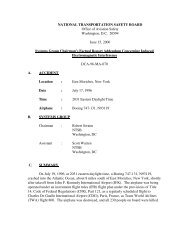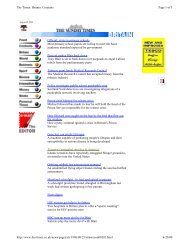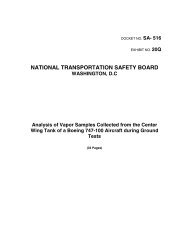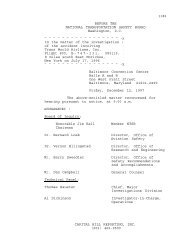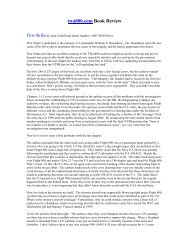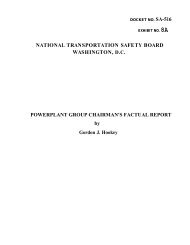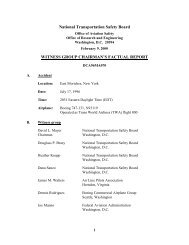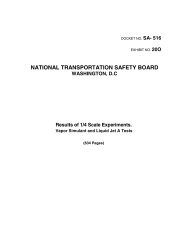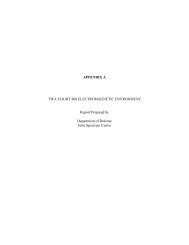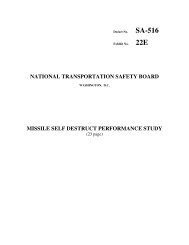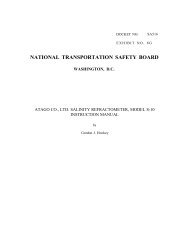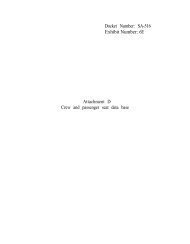Exhibit No. 11A - Group Chairman Factual Report - TWA Flight 800 ...
Exhibit No. 11A - Group Chairman Factual Report - TWA Flight 800 ...
Exhibit No. 11A - Group Chairman Factual Report - TWA Flight 800 ...
You also want an ePaper? Increase the reach of your titles
YUMPU automatically turns print PDFs into web optimized ePapers that Google loves.
16. Jettison Pump - Serial number 790293, located in the right wing, was removed from N93108 due totime. During the overhaul, the rotor, bearings, both plates, and element were replaced. The pump wassigned-off as overhauled on August 8, 1995, and tested on August 28, 1995. The pump was installed inN93119 on September 10, 1995. At the time of the accident, the time remaining for this pump was 6,114hours, with an estimated run-out date of October 14, 1997.(<strong>Exhibit</strong> G - Component Shop Record Cards and Testing Cards).FUEL PUMP OVERHAUL PROCEDURES<strong>TWA</strong>’s Kansas City, MO, maintenance base has an overhaul/repair shop to refurbish all of the pumpsutilized for <strong>TWA</strong>’s entire Boeing 747 fleet.The jettison pumps and the boost pumps are manufactured by Crane Hydro-Aire Division. Thescavenge pump and the APU fuel pump are manufactured by Lear Romec, a division of Crane. The <strong>TWA</strong>maintenance base repaired and overhauled these pumps in accordance with the manufacturers’ overhaulmanuals and <strong>TWA</strong>’s reliability control program specifications established or approved by <strong>TWA</strong>engineering.APPLICABLE SERVICE BULLETINS AND AIRWORTHINESS DIRECTIVES FOR THE FUELPUMPSAirworthiness Directive (AD) 79-06-02, effective April 19, 1979, (<strong>Exhibit</strong> H) required compliance asidentified in Boeing Alert Service Bulletin (SB) 747-28A2092, dated February 12, 1979, (<strong>Exhibit</strong> I) andrevised April 27, 1979, The SB, entitled Main Fuel Tank Pump Wiring Inspection, Rework andModification, was a one-time accomplishment. The inspection, repair, and modification was to precludeelectrical arcing into the <strong>No</strong>. 2 and <strong>No</strong>. 3 main fuel tanks. This arcing could have resulted from darnagedwires which provide power to the <strong>No</strong>. 1 and <strong>No</strong>. 4 main fuel tank boost pumps. <strong>Report</strong>ed chafing andabrasion was attributed to vibration of the wires against the conduit wall. <strong>TWA</strong> records indicate that theAD was accomplished by <strong>TWA</strong> maintenance personnel on June 6, 1979.Since the accident, the FAA has issued AD 96-26-06, effective January 21, 1997, (<strong>Exhibit</strong> J) whichrequires a one-time inspection to detect damage to the sleeving and wire bundles of the boost pumps of thenumbers 1 and 4 main fuel tanks, and the auxiliary tank jettison pumps if installed, replacement of anydamaged sleeving with new sleeving; and repair or replacement of any damaged wires with new wires.The AD further states that if any burned wires are found, inspection of the conduit and replacement of theconduit (if damage is found) is required.The FAA determined that an environment conducive to vibration exists in the conduit and wirebundles of the boost pumps and the auxiliary tank jettison pumps. This vibration could result in abrasionsof the Teflon sleeving and subsequent abrasion to the wire bundles.Service Bulletin 747-28A2194, dated August 3, 1995, and revised January 18, 1996, (<strong>Exhibit</strong> K)entitled Fuel - Distribution - Fuel Boost and Override/Jettison Pumps - Inspection, indicated that theaction was to access all of the 747 boost and jettison pumps to do an insulation resistance check on eachpump. Any pumps that did not pass the insulation resistance check were to be replaced. Boeingrecommended that the initial inspection be accomplished at the next opportunity when manpower andfacilities were available.16





